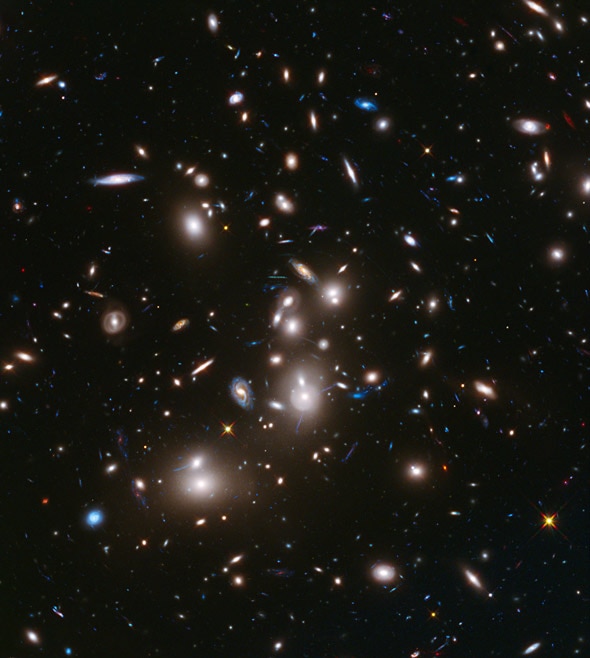Create a free profile to get unlimited access to exclusive videos, sweepstakes, and more!
Hubble Opens Pandora’s Box, and Thousands of Galaxies Fly Out

As I was putting together my Best Astronomy Pictures of 2013 page, I was thinking that it had been a while since I had posted a jaw-dropping Hubble shot of galaxies. And then Hubble delivered.
That stunning image shows Abell 2744, a huge cluster of galaxies located a mind-numbing 4 billion light years away. Also known as Pandora's Cluster, itâs actually four separate clusters of galaxies undergoing a massive collision.
I suggest you grab a higher-resolution version of the image (there's even a monster 3900 x 4360 pixel version). When you peruse it, take note: not every object you see in it is part of the cluster. Not even close. If you zoom in, youâll see lots of weird arcs and streaks:
Get this: Those are actually entire galaxies, located far, far behind the cluster. Pandora is so massiveâ400 trillion times the mass of our own Sun, a thousand times that of our entire galaxyâthat its combined gravity literally bends space. Light from the more distant galaxies gets bent as it passes through space near the cluster, distorting our view of them. The cluster is what we call a gravitational lens because thatâs exactly whatâs going on: The gravity is bending light similar to the way a glass lens does. I have a more detailed explanation in an earlier post if you want the back story on how this works.
Another fun benefit from gravitational lenses is that they boost the light from more distant galaxies. At huge distances galaxies are faint, of course. But if the light from a galaxy is focused by the gravity of a cluster, it appears brighter to us. This means otherwise invisible galaxies can be seen! Some of the galaxies in the Hubble image are incredibly far away, 12 billion light years away. That means we see them less than 2 billion years after the Big Bang itself, when the Universe was young (itâs 13.8 billion years old now).
Thatâs why Hubble stared at this same spot in space for a whopping 67 hours: To get the deepest images ever of a gravitational lens, to take a census of the cluster itself, and to see the soul-crushingly distant galaxies behind it better than ever beforeâitâs why they call this the Frontier Field (similar to the series of Deep Field images Hubble has taken over the years).
In the final image, more than 3,000 such distant galaxies can be spotted, some of which have a mass only 1/1,000th of our own Milky Way. Hundreds of galaxies are seen in Pandora's Cluster, and in total some 10,000 galaxies are seen scattered throughout the image, both between Earth and the cluster, and well beyond. This image is so deep that astronomers can actually see the light from stars in Pandora's Cluster that have been stripped out of their parent galaxies, victims of gravitational collisions between the galaxies.
This image is stunning. Back in the day, when I was gainfully employed calibrating and processing Hubble data, I worked with a few very deep ones. You could see galaxies strewn through them, scattered like plant seeds on the wind. The work to whip the images into shape was generally fairly routine, even tedious at times, but then sometimes Iâd suddenly see them for what they really were: Trillions upon countless trillions of stars, each photon of light in the image from these distant suns having traveled billions of years, losing energy as they swam upstream against the expansion of the Universe, finally stopping after that long, long journey when they hit the camera orbiting hundreds of kilometers above the Earth.
Iâd stop dead in my work, gaping, the hair on the back of my neck rising as those thoughts seeped into my brain. Even if you donât understand the science, canât grasp the physics, then know this: We humans yearn to reach across the Universe, to understand all that we see. And then we actually do this. When we try, we can see very, very far indeed.


























